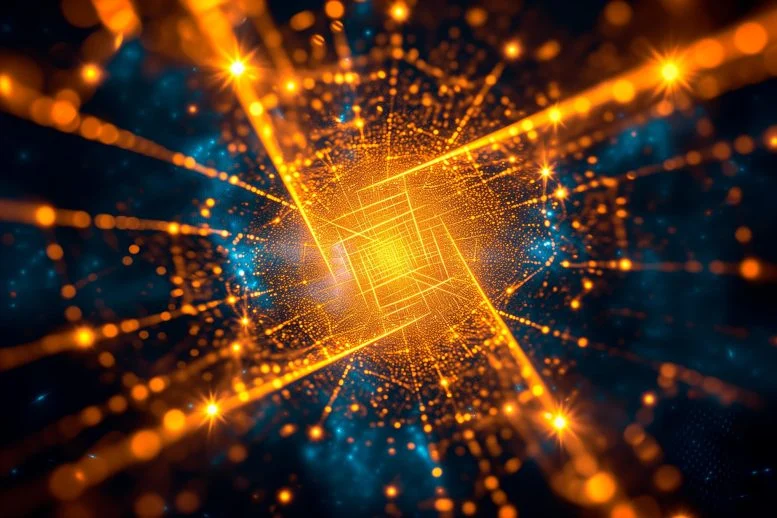
By University of California – Riverside August 23, 2024
Collected at: https://scitechdaily.com/revolutionary-superconductor-set-to-turbocharge-quantum-computers/
Physicists have developed a groundbreaking superconductor material that could revolutionize the scalablity and reliability of quantum computing components.
By combining trigonal tellurium with a gold thin film, they created a two-dimensional interface superconductor with enhanced spin polarization, which shows promise for creating stable spin qubits. The material’s transition under a magnetic field suggests it could be used as a triplet superconductor, potentially leading to more robust quantum computing components. Moreover, the new superconductor technology naturally suppresses decoherence sources, a significant challenge in quantum computing, using non-magnetic materials for cleaner interfaces.
Innovative Superconductor Breakthrough in Quantum Computing
A new superconductor material that could potentially be used in quantum computing and be a candidate “topological superconductor” has been developed by a multi-institutional team of scientists in the United States, led by physicist Peng Wei at the University of California, Riverside.
Topology is the mathematics of shape. A topological superconductor uses a delocalized state of an electron or hole (a hole behaves like an electron with positive charge) to carry quantum information and process data in a robust manner.
Chiral Material and Interface Superconductivity
The researchers report today (August 23) in Science Advances that they combined trigonal tellurium with a surface state superconductor generated at the surface of a thin film of gold. Trigonal tellurium is a chiral material, which means it cannot be superimposed on its mirror image, like our left and right hands. Trigonal tellurium is also non-magnetic. Nonetheless, the researchers observed quantum states at the interface that host well-defined spin polarization. The spin polarization allows the excitations to be potentially used for creating a spin quantum bit — or qubit.
Spin Polarization and Qubit Potential
“By creating a very clean interface between the chiral material and gold, we developed a two-dimensional interface superconductor,” said Wei, an associate professor of physics and astronomy. “The interface superconductor is unique as it lives in an environment where the energy of the spin is six times more enhanced than those in conventional superconductors.”
The researchers observed that the interface superconductor undergoes a transition under a magnetic field and becomes more robust at high field compared with low field, which suggests a transition into a “triplet superconductor,” which is more stable under a magnetic field.
Suppressing Decoherence in Quantum Computing
Furthermore, through collaboration with scientists at the National Institute of Standards and Technology (NIST), the researchers showed that such a superconductor involving heterostructure gold and niobium thin films naturally suppresses decoherence sources from material defects such as niobium oxides that are a common challenge for niobium superconductors. They showed that the superconductor can be made into high-quality low-loss microwave resonators with a quality factor reaching 1 million.
Implications for Quantum Computing Technology
The new technology has applications in quantum computing, a field that takes advantage of quantum mechanics to solve complex problems that classical computers or supercomputers can’t solve or can’t solve quickly enough, according to the multinational technology company IBM.
“We achieved this using materials that are one order of magnitude thinner than those typically used in the quantum computing industry,” Wei said. “The low-loss microwave resonators are critical components of quantum computing and could lead to low-loss superconducting qubits. The biggest challenge in quantum computing is to reduce decoherence or quantum information loss in a qubit system.”
Decoherence occurs when a quantum system interacts with its environment, leading to the system’s information getting mixed up with the environment. Decoherence poses a challenge for realizing quantum computers.
Unlike previous methods that require magnetic materials, the researchers’ new approach uses non-magnetic materials for a cleaner interface.
A Promising Future for Scalable Quantum Components
“Our material could be a promising candidate for developing more scalable and reliable quantum computing components,” Wei said.
Reference: “Signatures of a Spin-Active Interface and Locally Enhanced Zeeman Field in a Superconductor-Chiral Material Heterostructure” 23 August 2024, Science Advances.
DOI: 10.1126/sciadv.ado4875
Wei was joined in the research by his graduate students at UCR.
The UCR contribution to the research project was funded by Wei’s NSF CAREER award, a NSF Convergence Accelerator Track-C grant shared by UCR and MIT, and a Lincoln Lab Line fund shared by UCR and MIT.
The technology has been disclosed to the UCR Office of Technology Partnerships and a provisional patent has been filed.

Leave a Reply